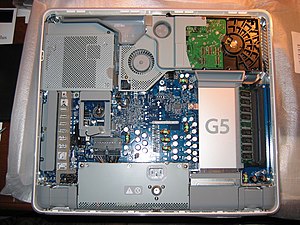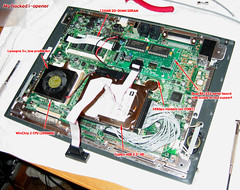Without much fanfare, Apple quietly released its ‘Mac for the Rest of Us’ today, January 11, 2005, via the new Mac mini. January had been a favorite month of Apple’s co-founder, Steve Jobs, to launch new products. Very memorable was the Jan. 24, 1984 unveiling of the very first Macintosh which was made even more astounding by the famous “1984-Big Brother” ad, which aired two days earlier -Jan. 22, 1984 -, during the halftime of Super Bowl XVIII between the L.A. Raiders and the Washington Redskins.
And so, off I went to the nearest Apple Store in our area (the Palo Alto Apple mini store inside the Stanford Shopping Center, was one of the very first Apple Stores to have the Mac mini on display) to check out this yet new release by Steve and his bright band of engineers.
The Mac mini is Apple’s latest -and, bold -attempt to lure Windows/PC users to the glamorous world of Mac OS X. Bold, in a sense that, this is the first time they released a “bare-bones” Mac. Normally, Apple bundles a keyboard and mouse for any system they sell without a monitor. Now, with the Mac mini, all one gets is the basic system or “CPU unit.” Users, will have to make do with his/her own monitor, keyboard and mouse to come up with a fully-functioning Mac. It’s “BYODKM” -Bring-Your-Own-Display-Keyboard & Mouse-, as Jobs aptly coined it at the recent 2005 MacWorld Expo held at the Moscone Center in downtown San Francisco.
The squat, 6.5″ x 6.5″ x 2″ aluminum-clad unit with a white-colored top comes with two (2) USB ports -obviously for keyboard and another USB-enabled device that is oh, so, very common in the world of Windows/PC-, one (1) FireWire port -for that much faster iPod/iTunes music and DV transfers -, a 10/100 Ethernet -for that essential, fast Internet-sharing/networking connection -, and the eternally-present, 56K modem port.
   
 
One drag, unlike in the iMac G5, is that the power supply was not built-in on the unit. Hence, another power brick is included in the package. The white-colored power cube (the size of which was similar to the one that came with the PowerBook 2400 series) provides a continuous 85W of power that the unit requires. The reason for not including the PS inside the tightly-packed unit must be due to the bitter lessons learnt by the company, in much of the power supply failures in their also miniscule, G4 Cube. Apple, in describing the Mac mini in their website, had tried their very best to hide this fact from web visitors, to deter at any ‘hint of clutter’ to the unquestionably elegant unit.
   
 
Windows ‘switchers’ won’t have to purchase any other adapters (most PS/2 keyboards or mice come with USB adapters anyway) to use the Mac mini right off the box. An analog (15-pin) VGA adapter is included so that you can hook it up to your VGA monitor. You may have to buy the Apple DVI to Video Adapter if you want to hook up your TV instead.
The built-in speakers may remind you of the sounds coming from your iBook but a headphone/audio-out connector seems to quell any mutterings of the audiophile…that is almost inherent in even the most casual of Mac user.
Aside from its size, it is the almost total quietness of the unit that seem to marvel the true Mac enthusiast. Normally, compact units,- even in the PC realm – generate a slight whine that emanates from either the power supply’s or CPU’s fan. Since Apple had almost perfected the art of convection-cooling,- and that the power supply is separate – when they released the G4 Cube, the unit merely sits in its utter stillness alongside any other widgets you may have on your desk.
Powered by either a 1.25 or 1.42 GHz G4 processor (but with a meager 167 MHz front side bus), a reasonable 256 MB of DDR (PC2700/333 MHz), 32 MB of video RAM (ATI 9200 Radeon…which I don’t believe won’t be supported under “Core Image” – one the most exciting features of OS X Tiger – unless Apple engineers rewrite the code once again), a slot-loading Combo drive and with the gorgeously-stable Mac OS X loaded up in either a 40 or 80 GB of ultra ATA hard drive, the package will definitely be hard to resist for anyone who would like to give the elegant Mac OS X a spin, the first time around.
Is the price of $499 (about $540 net, inclusive of the 8.25% sales tax in this part of CA) for the base unit, right? It depends. With prices of used, all-in-one iMac G4s (complete with monitor) plummeting due to the release of the iMac G5, one who can get a deal for the former within the $500-$700 range, can forget the new Mac mini altogether.
But, if you’re the PC user who already has an LCD monitor and would like to try the world of OS X -and with the much talked-about Mac OS X Tiger looming in the horizon-, it’s a price that will be too hard for you to resist.
The G5 iMac
Exactly two weeks ago, we went to the new Apple Store in Pleasanton, CA to take a glimpse of the remarkable G5 iMac which Apple released in mid-September.

The new store – opened Sept 18 – was inside the Stoneridge Shopping Mall which, in turn, was conveniently situated at the junction of Interstates 580 and 680 — two busy freeways that connect Central California and North Bay commuters to the East Bay portion of Silicon Valley.
From our house, the closest Apple Store prior to this one was either the outlet in Palo Alto (inside the Stanford University campus) or, that spacious store also located inside a huge mall along Stevens Creek Blvd in Santa Clara.
Store employees – clad in black T-shirt with the white Apple logo – eagerly greeted customers and almost automatically, ushered them to the area where the new iMac G5 were showcased.
There were four (4) iMac G5s on hand – two 17″ and two 20″ ones – for customers to try their hands on. I immediately seized the opportunity to demo the 20″ model – with an Apple iSight camera on top of the screen – after a bearded Apple fanatic, was done with his turn — closing all his Final Cut Pro rendezvous — on the dazzling snow-white colored machine.
The first thing I did was examined the physical details of the machine – top, side, front and back. I tilted the screen into varying angles and observed whether the anodized aluminum stand was stable. I was also very impressed with the G5 iMac’s simplicity while not having to skimp on the needs of today’s digitally-addicted computer users. All the ports – digital & analog sound jacks, USB, FireWire, 56K (V.92) modem, 10/100 Ethernet and video out – were neatly arrayed at the back including the power switch.
The front was so pristine – no controls to distract the user’s visual interaction with the stunning display – with the exception of the silver Apple logo imprinted on the white plastic case — to probably serve as a reminder to the users, of the company that brought computing Utopia to them.

The machine’s technical elegance can be seen mostly at the back. Heat dissipation was done via a 1/4″- wide horizontal slit on the machine’s removable back cover. You can feel a very light wisp of hot air gently blowing -courtesy of three (3) microprocessor-controlled fans inside – when you place your hand along this slit.
I’m skeptical whether this method will be ample enough (even without room air-conditioning) when the unit is used in tropical/humid countries like the Philippines. Also, I was not so sure of the machine’s reliability and stability when used as a 24/7, 365 day a year web server. I had long proven the reliability of their G4 (Sawtooth) – as well as the much older G3 iMac (the original, multi-colored model) – because of their bigger cooling fans.
The sound may be a bit on the minus side but the quality was not lame. The two stereo speakers were hidden from view – cleverly crafted at the bottom of the 2″ wide panel, to enable sound to bounce-off from the desk or table where you place the unit.
The new G5 iMac was spiffy enough even with only the base 256 MB of DDR RAM installed. I opened several programs while simultaneously playing two (2) video playbacks via QuickTime and iDVD, and noticed only very minimal video refresh delays even when the other programs were opened and put into action. The machine’s default OS X Panther (10.3.5) seemed to be a good match for the processor’s 64-bit capability.
Lastly, the bundled keyboard and mouse -while not their top-of-the-line-models – complement the overall simplicity of the G5 iMac. As advertised, the keyboard tucked neatly under the stand when you’re done using this nice piece of computer cum art piece. Although, I noticed, that the base of the aluminum stand had already some minor scratches on it, I’m not sure whether they were due to the keyboard’s feet constant rubbing when stowed underneath or for some other reasons.
The price also came as a surprise at a modest $1,299 – this is their cheapest compared to Apple’s previous iMac releases – for the entry level, 1.6 GHz, 17″ screen model with Combo Drive.
Much as I would like to get one that very same day, I was disappointed to come home empty-handed. The Apple G5 iMacs are selling like donuts. There was a long waiting list even if you buy it at a brick and mortar Apple Store!
Ordering it online will set you back for almost a month: time that will be spent in extreme anguish or even mild paranoia.
Meanwhile, Apple fanatics like me will just continue to drool and to hope for the best that, one day, they will be able to snag any one of these new creations that came from the Mecca of Computing in Cupertino.
—notes:
Almost three weeks after we dropped in at this store and after contacting all the Apple Stores in Northern California and signing-on in their waiting lists, this author finally went home with a 1.8 GHz, 17″ screen model of the G5 iMac — from nearby Santa Clara, CA.
—links:
View the author’s iMac G5 slide show: LOW (320 x 240) | HI (640 x 480)
The Netpliance hack parts….
The iOpener hack parts arrived via UPS a week after I had ordered them from an East Coast computer parts company. I could

have also bought the parts locally -and cheaper – but I don’t like to bother with the hassle of assembling them – specially the 44-pin IDE cable for the laptop HD that will hook up to the iOpener. The driving time to buy them locally will also offset whatever savings I can.
Aside from the cable, there is also the IDE adapter as well as the actual laptop HD (3 GB).
Total cost: $50.
Waiting for the Netpliance iOpener hack parts
The thing had been sitting on a makeshift shelf on the garage – very close to the roof. I had only tested it briefly after I had acquired it from an estate auction in Dec. 2002 (too bad, I missed to get the compatible Canon printer in the same auction!!! Grrr).
Back then, it was still fairly a popular hobby for hardware guys to hack this piece. But, back then, maybe I got too much stuff to attend to and forgot the iOpener altogether.
Suddenly, last month – after I set up yet another PC/TV for my parents in our living room – using the assortment of PC hardware strewn in all parts of the garage – the final product doesn’t seem to appeal to me aesthetically. Ding! Ding! Why not use a hacked iOpener instead?
Maybe it’s fortuitous…Parts for the hack would have been considerably steeper had I done it earlier! Now, I’m simply waiting for the UPS truck to arrive!!!
—notes:
You can see the ‘blow by blow’ account’ of the iOpener transformation (hack??) here.
After a month of on-off-on work, on 6/01/04, the hack was done. You can see the finished product here.


